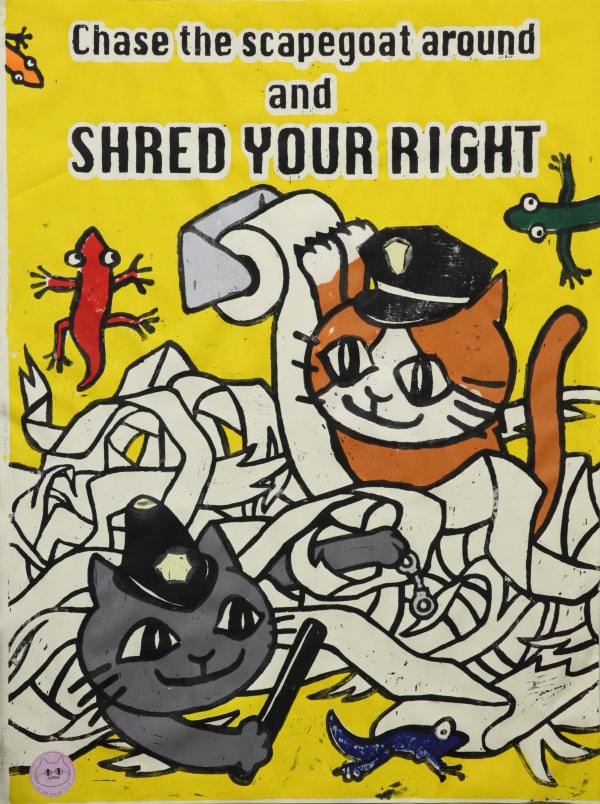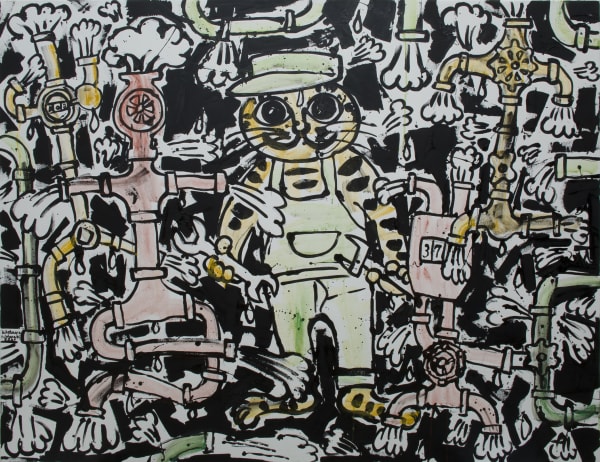-

© Nobuaki Takekawa, Courtesy of Ota Fine Arts (Shanghai/Singapore/Tokyo)
-

Details: Nobuaki Takekawa, Demolition of Rice Pyramid, 2020, Acrylic on canvas, 159 x 253.4 cm
© Nobuaki Takekawa, Courtesy of Ota Fine Arts (Shanghai/Singapore/Tokyo)
-
— Can you please let us know how you are experiencing the Covid19 pandemic, in Japan? To what extent has your everyday life as an artist changed in self-quarantine?
Two years prior to the Covid-19 epidemic, I often went to China to interact with local artists, but this connection is now blocked by the pandemic. Now I have more time to re-organize the house, studio and yard, and to rest and care for my health, which I have not been able to in the past. I can also spend time with my family while making new works.
-
-
-

Nobuaki Takekawa's tattoo, "a piece of duck blood"
© Nobuaki Takekawa, Courtesy of Ota Fine Arts (Shanghai/Singapore/Tokyo) -
— Nature and animal are key motifs of your current exhibition at Ota Fine Arts Shanghai. Is there a specific reason why you chose them as a major source of inspiration of your works?
When social issues become the subject of artworks, or when works are presented in regions with different political systems, anthropomorphic expression is a powerful method because it can present critical content in an entertaining way. Hence, achieving the purpose of delivering a clear message. Moreover, in globalized cities where Modern and Contemporary Art have been introduced, the universality of the Fable narrative form has the effect of reinforcing a succinct context.
-

Nobuaki Takekawa, Cat's Water Work Site, Acrylic on canvas, 194 x 259 cm
© Nobuaki Takekawa, Courtesy of Ota Fine Arts (Shanghai/Singapore/Tokyo)
-
— Reviewing the original intention of creating the Cat Olympics themed installation art, is there any comment you would like to add for the upcoming Tokyo Olympics this July?
In fact, prior to the Covid19 pandemic in Japan where the power of the state was declining, the lack of proper preparations for the Olympics already existed. Political failure resulted in rampant corruptions, budgets were inflated and yet the contents were not satisfactory. In addition, other social issues were exposed one after another. I think it would be wise for Japan to cancel the Olympics. Regardless, the "Human Olympics" this time can be seen as a failure. -
-
About the Artist
Nobuaki Takekawa (b.1977) was born in Tokyo, Japan and received his BA in Fine Arts at the Tokyo University of the Arts in 2002. In recent years, Takekawa has participated in Yokohama Triennale 2020 - AFTERGLOW, “Relay to Tokyo – Inheriting and Gathering”, Byzantine and Christian Museum, Athens Greece, 2020, Roppongi Crossing 2019: Connexions: Mori Art Museum, Tokyo, Japan, 2019, Our Collections!: Tottori Prefectural Museum, Tottori Prefecture, Japan, 2019, Rebel Without a Cause: The Watari Museum of Contemporary Art, Tokyo, Japan, 2018, and the 9th Vladivostok International Biennale of Visual Arts, State Art Gallery of Primorsky region, Primorsky Krai, Russia. In 2018, Takekawa participated in the Sifang Art Museum residency "Huge Huge" in Nanjing, China. His works are held in public and private collections including the Ford Foundation, U.S.A, National Museum of Art, Osaka and the Collection Lambert, France, etc.
To learn more about the artist, please click here.
Past viewing_room
Join our mailing list
* denotes required fields
We will process the personal data you have supplied to communicate with you in accordance with our Privacy Policy. You can unsubscribe or change your preferences at any time by clicking the link in our emails.













